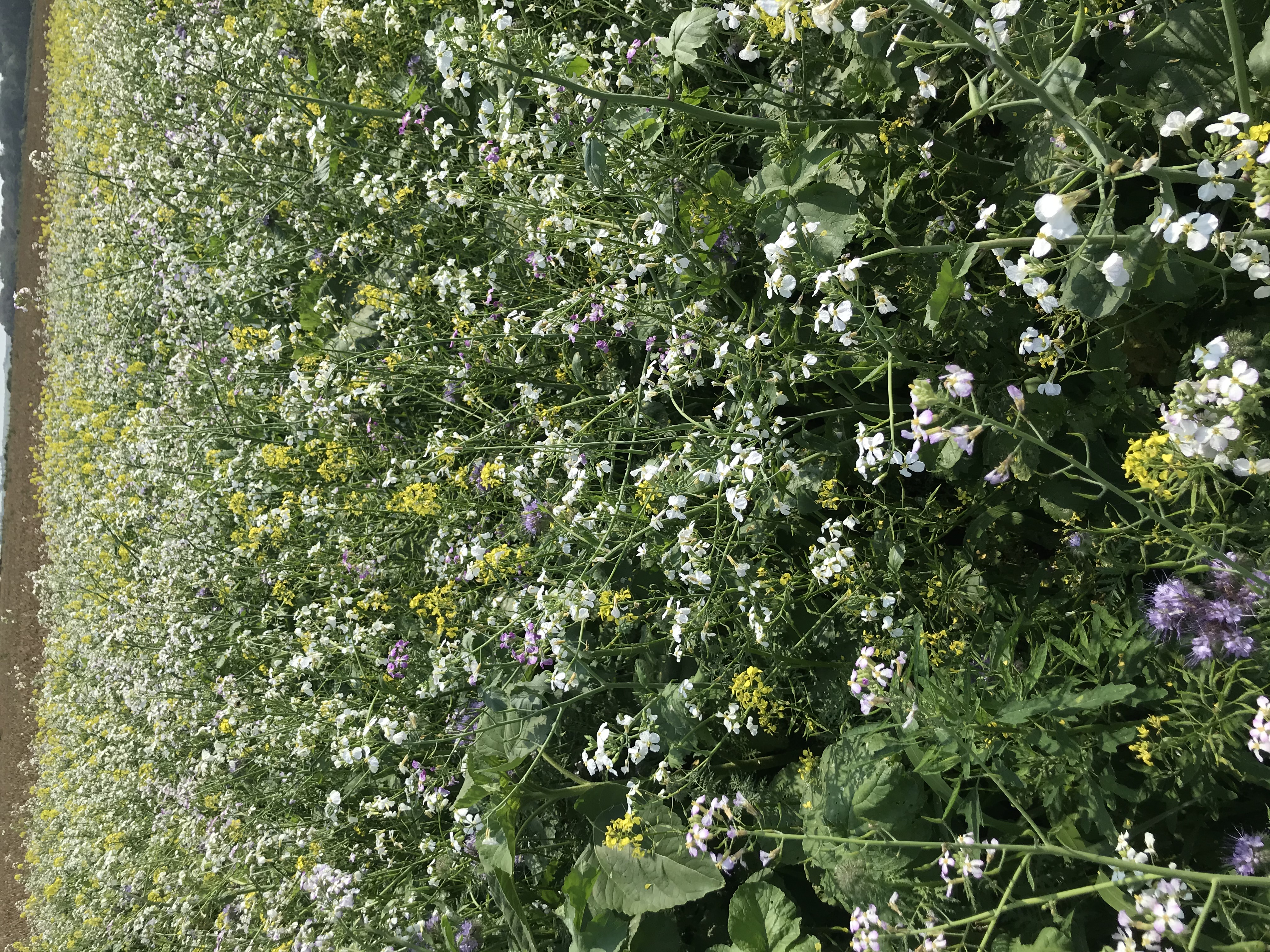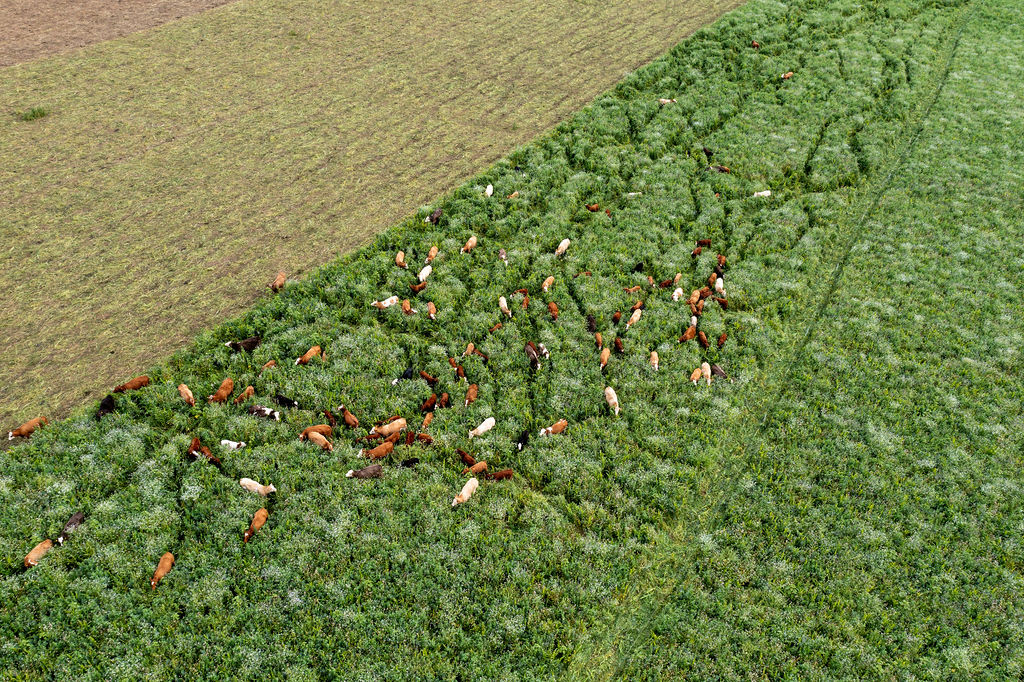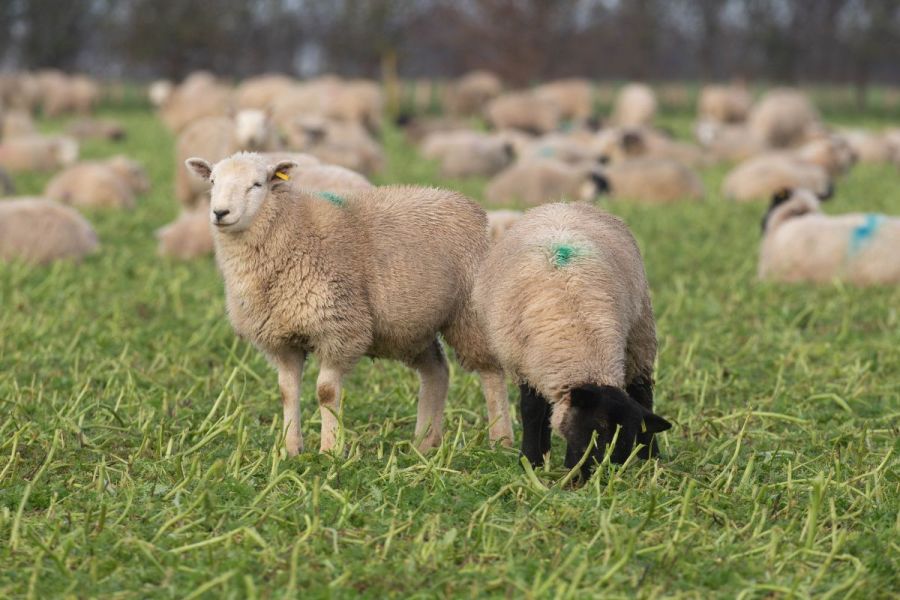With cover cropping becoming ever more commonplace, the idea of using animal impact is gaining in appeal for arable farmers. But how do grazier and crop grower each get what they want from grazing agreements? CPM finds out.
Eating a third, trampling a third and leaving a third isn’t wasteful, in fact it ticks everyone’s boxes
By Emily Padfield
Planting a winter break crop, such as stubble turnips, to utilise and create winter fodder for livestock is nothing new. But what can be a lucrative and successful fattening or winter feedstock for livestock perhaps doesn’t always hold the same benefits for the soil, fertility or indeed the following year’s crop.
While these stubble and brassica crops have been a go-to for growers with lambs to fatten or ewes to out-winter, the result is often brown bare fields at the end of winter and shallow compaction due to over-grazing during wet periods.
But managing cover crop choice to deliver long-term benefits in terms of the following crop, soil structure, nutrient cycling and erosion prevention can also offer good quality tucker for hungry mouths over the winter period.
These outcomes are key to grazing agreements but cover cropping can be quite a divisive topic, explains Chris Taylor, technical specialist at Agrii and 2022 Nuffield Scholar looking at how regenerative farming practices could pave the way in meeting targets for net zero.

It’s typical that growers want a number of results from their cover crops – to add fertility, provide ground cover, graze and use plant roots to reduce compaction without mechanical intervention. In that scenario, rarely does a single species ever tick all the boxes, says Chris Taylor.
“Sometimes you can inadvertently do the wrong thing while having the right intentions when it comes to cover cropping, and it can have quite dramatic results which can put people off really quickly,” explains Chris.
“I always start with: ‘What are you trying to achieve?’ Often there are numerous things and it’s about determining a priority list. It’s vital to consider what the previous and following crops are and what window you have to work in. This decision process goes for grazing the cover crop as well.”
Cover crops have the ability to mop up, hold and fix nutrients; reduce leaching; increase organic matter; improve soil structure; supress weeds and provide a habitat for wildlife, but only if they are correctly managed, he stresses.
“I like to have some parameters in place as a starting point and then make sure the cover crop that we put in isn’t going to pose problems further down the line in terms of soil borne diseases or weed issues in following crops.
“To paraphrase Joel Williams of Integrated Soils, he teaches that if you have a single outcome you desire from a cover crop, then a single species can often deliver that outcome as it’s very targeted,” he says.
“But it’s far more typical that growers want a number of results from their cover crops. They want to add fertility, provide ground cover, graze and use plant roots to reduce compaction without mechanical intervention. In that scenario, rarely does a single species ever tick all the boxes.
“Also, whereas it’s completely possible for a single species to fail, I have never had a multispecies fail due to other species stepping in to fill the gaps.”
It’s also important not to generalise with choice of cover crops as no two farms are ever the same, he adds. “The challenge in my opinion is to balance what the farmer wants and how to achieve that. That’s why it can sometimes be difficult working with graziers, as what the grower wants can sometimes be undermined by how livestock are grazed.”
It’s better to have an arrangement that the person grazing has a per head/per week basis rather than a whole season, in Chris’s opinion. “I have tried to instigate a bit of a mindset change and explain that eating a third, trampling a third and leaving a third isn’t wasteful, in fact it ticks everyone’s boxes.

Species that sheep really don’t enjoy grazing like buckwheat and phacelia can be slipped into mixes, which both bring huge benefits for the soil with the added bonus of being left when livestock move on.
“That’s another reason why I like multispecies mixes, as you can slip species in that sheep really don’t enjoy grazing like buckwheat and phacelia, which both bring huge benefits for the soil with the added bonus of being left when livestock move on.”
Quite often, buckwheat is gone by the time sheep come on to graze, but it’s had time to liberate the phosphate and provided early flowering for pollinators, while having a deep tap root for compaction alleviation. The root architecture stays in place giving good winter drainage channels and typically you don’t need to use a chemical to terminate it, so it’s a win-win really, says Chris.
Because each grower’s wish-list differs greatly, Agrii now offers base cover crop mixes with bolt-on options to increase species variety to deliver targeted outcomes.
“Species like forage rye are good for filling the hunger cap in February/March. It doesn’t create too much biomass pre-Christmas but does through February and March. Spring or black oats are also good as they don’t need fertiliser to get up and grow, although you can run the risk of them setting seed if you’re not quick enough to graze.
“Some people don’t choose to put any cereals in a mix and instead rely on volunteers, however if straw has been chopped you might have a heavy dose of volunteers behind the combine and nothing either side, which can shroud out other species and is worth bearing in mind,” he suggests.
“Following my recent travels in Canada and the US visiting a number of organic farms, I learnt that investing in 18 months or so of fertility building ahead of a nitrogen hungry cash crop shouldn’t be seen as a waste, especially if you can run livestock over the crop to create another income. It’s just a change in mindset.”
Key considerations for cover crop choice
- Previous/subsequent crop
- Time of drilling
- Soil moisture level
- Pests
- Establishment technique
- Drilling rates
- Soil nutrients
Thinking outside the box
Sheep have always played a role on Richard Tustian’s mixed family farm In Oxfordshire, with the traditional North Country Mule flock historically lambing inside in spring and fattening off grass during the summer.

Since the management of the farm has gone in a more regenerative direction, Richard Tustian has been thinking about how to design a sheep system more in-sync with both arable workload and grazing availability throughout the year.
But since the management of the farm has gone in a more regenerative direction, Richard has been thinking about how to design a sheep system more in-sync with both arable workload and grazing availability throughout the year.
“We haven’t got a massive amount of permanent pasture,” he explains. “Ideally I want to reduce the livestock workload in the summer and also reduce the number of mouths to feed too. I want to lamb in September, when the workload is less but the weather is still kind. We should have got the oilseed rape in by then and there’s a lull before drilling the wheat,” he explains.
“Ultimately, I want to get the highest price for my lambs with the least cost, which obviously everyone does. But by lambing in September and finishing in time for the Easter market hopefully I can reduce costs and spread workload.”
The natural choice for an autumn-lambing breed is the Dorset Horn, but this woolly breed brings its own issues for those wishing to go down the low-maintenance flock route.
Luckily for Richard, the ideal cross came up recently when a flock of Dorset composites came up for sale relatively close-by. “It’s 65% Dorset, with a mixture of Finnish Landrace and British Milksheep that the owner had been breeding for the past 40 or so years.”

Both grazier and land manager have to have the ‘eat a third, trample a third and leave a third’ mindset.
This cross not only brings the ability to cycle and lamb in September from the Dorset, but good milk production from the Milksheep. Added to that is the prolificacy of the Finnish Landrace, which is known for having three, four and five lambs as well as having a short tail.
“In a perfect world it would be shedding as well, as shearing in summer could be a concern for newly in-lamb ewes, but this year I have been happy with the scanning percentage of 190% despite having to turn them over just after tupping.”
Richard will be experimenting with an Exlana tup over his Dorset composites this year as well as running 200 or so Exlana ewe lambs with the idea of tupping them with the rest of the flock next summer.
Exlana genetics, which centre around shedding and worm resistance, include some genes from the Barbados Blackbelly, which has the ability to cycle year-round like the Dorset. So hopefully this will result in some of these joining the rest of the September lambing flock. Those that fail to cycle in early summer will be sold as theaves at a price governed by the Exlana Breed Society, with enough time to tup later in the year.
Richard has recently taken over the winter grazing of 100ha of cover crops on nearby Edgecote Estate, who have had several sheep farmers graze their cover and fodder crops over the years.
“We have the same mindset and because I plant and graze my own cover crops, I understand what is expected when grazing theirs,” he explains.
“Richard understands that we need living roots and a good amount of green cover left after his sheep have grazed and he is completely on board with the ‘eat a third, trample a third and leave a third’ mindset,” farm manager Ben Whale goes on to add. “What we don’t want is a bare, brown field at the end of the winter.
“Depending on how it goes in this first year, I would like to think we can have open dialogue about choosing the best cover crop mixes that benefit both parties,” explains Richard.
He aims to run the flock in one mob wherever possible and graze parcels of 1ha with frequent moves using a Rappa electric ATV fencing system. “Each field will be entirely fenced round the outside then strip grazed for ease and speed of movement.”
Hybrid grazing and management agreements possible
Balbirnie Home Farms comprises more than 800ha arable and 200ha of grassland near Glenrothes in Fife. The estate has a traditional seven-year rotation, each year growing a quarter winter wheat, a third spring barley with the rest being split between oats, winter barley, potatoes, parsnips and carrots.
The 300-head cattle herd is grazed mostly on hill ground during the summer, with cattle housed during winter and fed a balanced diet of silage, barley and waste vegetables all produced on farm.
A holistic approach to management has seen the farm adopting mob grazing to better utilise forage to good effect, explains managing partner Johnnie Balfour.

Balbirnie Home Farms has experimented with planting summer cover crops, which can provide cattle grazing later in the season on what can be a very high dry matter yielding crop.
“Historically we’ve let the winter grazing out for sheep to ‘cleanup’ grass fields. This has meant eating everything down to nothing to then apply fertiliser in the spring to start over again. Now we rest those fields and have an aim to allow each block 100-day rest periods before grazing.”
Cattle are all mob grazed across the grassland acreage. The farm has also experimented with planting summer cover crops which can provide cattle grazing later in the season on what can be a very high dry matter yielding crop.
“One year this worked spectacularly well. The margin on it was touch and go but because it was such a good entry into the following wheat crop and we were able to significantly reduce nitrogen inputs we thought it was worth pursuing on that basis,” says Johnnie.
“However, with weather issues the following year, the variability in quality and quantity made it an unreliable option for us.”
But grazing with sheep is another thing altogether, he goes on to add. “We winter graze sheep on our arable crops. Currently we are drilling wheat and undersowing with clover. The wheat will be grazed over winter to keep it clean. After harvest the clover will be a living mulch which we’ll plant the next crop into.”
Five-year multispecies leys that don’t include ryegrass are included in the rotation and established for both grazing and forage, with the benefits to nutrient cycling being clearly seen in the following arable crops, adds Johnnie.
Recently, the farm has entered into an agreement with a couple that have not only taken over the management of the cattle but also graze their own flock of sheep on the estate as well. “We had the land but not the sheep and they had the sheep and no land, so it made sense.
“We initially advertised for an employee to manage the cattle operation but found that the couple that approached us had the leadership skills and drive to manage our existing cattle and set up their own business with access to land. We had a need for grazing skills – they had those, and we had the land. It’s still early days but we hope this will be successful going forward.”
The sheep will be used to manage and graze pockets of land not grazed in the past as well as mob graze cover crops and permanent pasture to better utilise forage, he adds.
“We’ve specifically outlined what we expect of grazing, that we want animal impact to be targeted properly and for nothing to be grazed for longer than three or four days before moving on. They are completely on board with that.”
This article was taken from the latest issue of CPM. For more articles like this, subscribe here.




